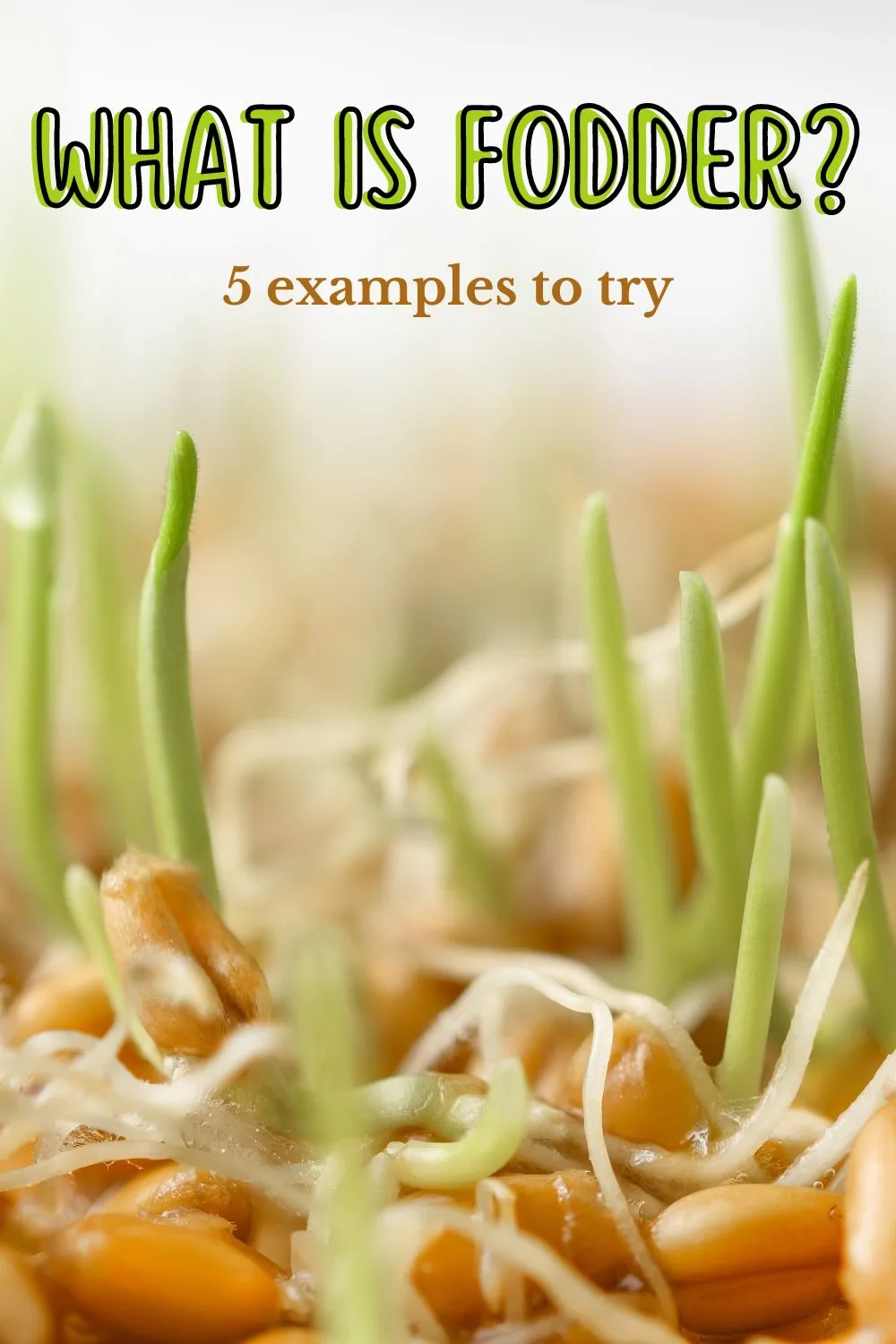What is fodder? Usually, fodder is made of sprouted grains used as animal feed by small ranchers, hobby farms, and homesteaders.

You can use many types of fodder to feed your animals, including hay, straw, silage, compressed and pelleted feeds, oils and mixed rations, and sprouted grains and legumes (such as bean sprouts or malt).;
What is Fodder In A Nutshell
- Hay – grass, legumes (peas, beans, and lentils), or other green plants that have been cut, dried, and stored to use as bulk fodder for grazing animals in the winter.
- Silage – grass or other green fodder which has been cut, compacted, and stored in airtight structures (silos), without first being dried. Stored in this way, it retains high moisture content and even ferments over time. Silage is used to feed ruminant (cud-chewing) animals during the season when pasture grass is unavailable. (Ruminants include cows, sheep, and goats, but not horses or pigs). Corn silage is one of the most commonly processed because it is high in energy and easy for the animal to digest.
- Pellets – compound manufactured feed formed into pellets or (cattle) cake
- Chaff – crop residues like straw, chaff, or stover. It is eaten as fodder, but it is not as nutritious as hay or silage
- Grain – seeds and grains, bran, maize, sorghum, “sweet feed”- rich, highly concentrated supplements, fed in limited amounts, often for “fattening up” an underweight animal.
- Sprouted grains and legumes – fodder in the form of sprouted grains and legumes can be grown in small or large quantities, from a few simple sprouting trays for the small family homestead to cutting-edge, climate-controlled hydroponic “Fodder Factories,” which can produce more than 2 tons of high-quality, super-nutritious fodder PER DAY!
Hydroponic Fodder Growing Systems
People who prefer hydroponic fodder (sprouted grain) say it carries nutritional benefits unavailable in un-sprouted grains, harvested hay, and fresh pasture grass.
Hydroponic fodder advantages
- Superior nutrition and hydration
- No fertilizer, herbicides, or pesticides
- Low water consumption; ideal for drought areas
- Most economically feasible for grass-fed milk production, organic-certified operations, areas where sufficient and consistent pasture production is limited, hay is scarce or expensive, and drought-prone areas.
So, hydroponic fodder systems make the most sense for organic and grass-fed livestock operations, smaller family farms, hobby operations, and horse stables. It can be a significant feeding option when pastureland and hay are in short supply and will add a highly nutritious and delicious supplement to traditional grazing.
Interesting fact: Although products such as barley seed technically are grain, when sprouted grains are fed to cattle, they qualify as “Grassfed Beef” by the American Grassfed Association.
Hydroponic fodder disadvantages
- A high initial cost for the system
- Labor costs to process, maintain, harvest, and feed the fodder can be substantial for large operations.
- A typical hydroponic environment must be maintained (moderate temperatures and humidity); however, the hydroponic solution is NOT necessary: only clean water
- Mold potential
In conclusion, hydroponic fodder systems do not appear to be an economically feasible option for large-scale livestock farms which already have plenty of consistently productive pasture and access to high quality, reasonably priced hay
Fodder Solutions
Large-scale cattle ranches or thoroughbred farms usually have thousands of acres to feed their livestock. But the medium and small-sized rancher may be cramped for adequate space (acreage) to graze their stock. These folks need a good fodder solution.
According to the USDA, it takes 1-1/2 to 2 acres of high-quality pasture grass per cow or horse. And in the winter, when the grass stops growing (even in Florida and Southern California), you must buy hay and grain to keep your livestock fed.
Furthermore, many experienced livestock owners say this is the bare minimum and that 3 or more acres per animal would be much better. All that land must be seeded, fertilized, and watered. Wow! That’s a lot of expensive land, hard work, and expense to keep those animals fed!
Also, processed fodder such as hay, silage, chaff, and grains are expensive and prone to spoilage.
Is there an answer to this problem? An easier, cheaper, more nutritious way to feed a small to medium livestock herd on your hobby farm or homestead? A viable, affordable fodder solution?
Yep, there is! The hydroponic process (using the Nutrient Film Technique, or NFT) has proven to be a fantastic solution for growing lots of highly nutritious fodder in a very small space. Hydroponic systems are the perfect fodder solution!
From seed to feed in 7 days!
Hydroponic systems have been developed recently, allowing tons of sprouts to be produced year-round daily. This has provided a unique, affordable fodder solution for thousands of ranchers.
Sprouted grains can significantly increase the nutritional value of the grain compared with feeding the ungerminated seeds. In addition, they use less water than traditional forage, making them ideal for drought conditions. Sprouted barley and other cereal grains can be grown hydroponically in a carefully controlled hydroponic environment.
In only 7 days, you will produce sprouted fodder at about 6″ tall with a 2″ root mat, the peak size for feeding livestock. The animals eat both the sprouts and the root mat with obvious relish.
What You Need To Make Fodder
Seeds or grain
You’ll need seeds or grains suitable for sprouting or growing into fodder. Common choices include barley, oats, wheat, alfalfa, and various grasses.
Water
Adequate water supply is crucial for growing fodder. The seeds need to be soaked and then irrigated during the growing process.
Fodder trays
Fodder is often grown hydroponically in trays or containers. These containers should allow for proper drainage and air circulation.
Growing medium
A suitable growing medium, such as soil or a hydroponic substrate, is necessary for the seeds to sprout and grow. Some systems use a hydroponic mat or similar materials.
Light source
Depending on your setup, if natural sunlight is insufficient, you may need a light source for the initial germination phase. Learn more about grow lights.
Temperature control
Maintaining the correct temperature is important for successful fodder production. Seeds typically require a warm and humid environment for germination and early growth.
Learn more about the optimal grow room temperature.
Ventilation
Proper ventilation helps prevent mold or fungal growth. Good air circulation is essential to ensure the health of the growing fodder.
Harvesting tools
When the fodder reaches the desired height, you’ll need tools to harvest it. This could be as simple as a knife or scissors, depending on the scale of your operation.
Storage
Once harvested, fodder must be stored properly to maintain its nutritional value. Proper ventilation and protection from pests are essential considerations.
Nutrient solution (optional)
Some systems use a nutrient solution to enhance the nutritional content of the fodder. This is common in hydroponic or soilless systems.
How to Make Fodder – Step By Step
- select and measure grains/seeds
- rinse
- soak
- drain and spread
- wait for germination
- keep watering
- ensure ventilation
- add lighting (if needed)
- wait for growth of 4 to 6 inches
- harvest
- feed livestock
Tips
- Experiment with different grains and seed mixes to find what works best for your animals
- Monitor for signs of mold or spoilage, and adjust your process accordingly
- Keep records of your fodder production to optimize your process over time
Remember that specific details may vary based on the type of grains or seeds you use and the environmental conditions of your location. Adjust the process accordingly and seek guidance from local agricultural experts if needed.
Above all, have fun trying new combinations that help your livestock stay healthy and productive.

Stella and Simon, a couple of back-to-the-land, baby boomer enthusiasts, have embraced the world of homemade hydroponics on their three-acre plot of Florida piney woods. Their journey began after drawing inspiration from Epcot Center’s hydroponics exhibit, and they've delved into various hydroponic methods, experimenting with different systems, configurations, and crops both indoors and outdoors. Their expertise culminated in the creation of an innovative homemade hydroponics greenhouse, documented in their book, Simon’s Super Simple On-the-Grid, Off-the-Grid Hydroponic/Aquaponic Survival Greenhouse.





